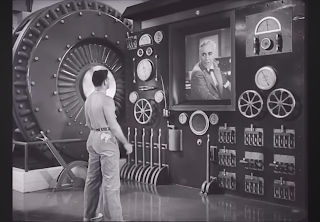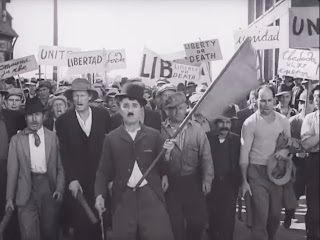This blog is a thinking activity assigned by Barad Sir. In this, we shall analyse the frames of the movie, ‘Modern Times’ and connect them to the setting of 20th century. For more information, you can check out this blog.
Released in 1936, ‘Modern Times’ is an American film, produced, written and directed by Charlie Chaplin. Chaplin also plays his iconic character Little Tramp for the last time in this film. It shows the character trying to adapt to the industrial world. The film was only a partial talkie and is often called the last silent film.
Mechanisation of Modern Times:-
The very first frame of the movie is a clock. Through this, we can understand the human bondage of time because we all are invisibly tied by clock or calendar. We have to perform certain tasks in a certain period of time. This shows the mechanisation of modern times and the demand for productivity in the industrial world. The 20th century saw more technological progress, than all the other centuries combined. This led to a monotonous lifestyle, ruled by time.
Theme of the movie:-
The opening line of the film is: ‘“Modern Times’. A story of industry, of individual enterprise ~ humanity crusading in the pursuit of happiness.” The opening lines of the film, describes the main theme that Chaplin wanted to convey. By reading the opening lines, the audience gets an idea that the film will explore the interplay between industry, individuality, and the human quest for happiness. By the use of words like “individual enterprise” and “humanity crusading”, one can sense the upcoming tension between the industrial world and human desire for personal freedom.
Developing herd mentality:-
Through just two frames, Chaplin manages to convey the message of herd mentality to his audience. The first frame is of a herd of sheep and in the second frame, they transition to human workers. This shows how in the 20th century, people suffered from the loss of individuality. They followed each other without much thought.
Power of money over power of muscle:-
In this frame, we see a muscular worker taking orders from a frail old man. This shows the transition of power in modern times. In olden days, those who were physically strongest would rule the others. This is no longer applicable in our time. The people with power of money and mind rule over others. Hence, in this scene the stronger individual is a worker while the old man is the boss because of his money.
Advance Technology:-
The technological advancement of the 20th century can be seen in these frames. The boss of the factory can see what everyone is doing and control people using technology. When he sees the Little Tramp in the bathroom, he even reprimands him. We can connect this to CCTV cameras of our times that monitor everything. However, it is noteworthy that CCTV cameras were invented in 1942 while this film was released in 1936. This shows Chaplin’s predictions of a future where everything will be monitored.
The scene of the boss keeping an eye on everything is also reminiscent of George Orwell’s ‘1984’, which has the famous ominous line “Big Brother is watching you”. In that novel, the people were always under surveillance and hence, were never truly free.
Exploitation of Labourers:-
In this scene, we see how Little Tramp is chosen to demonstrate on a feeding machine. This machine could feed the workers without the use of hands. They can eat while they work. This would eliminate lunch breaks so that factories could function more efficiently and produce more than their competitors. The malfunctioning of this feeding machine leads to a comical situation. However, through this hilarious scene, Chaplin comments on the dark side of Capitalism. Through this scene, we see how efficiency is prioritised and there is a mechanisation of even the basic everyday task. If not absolutely necessary, people would not be given even the few moments of rest. It shows the absurd lengths capitalism might go to in pursuit of higher productivity. The simple scene shows how the profit driven society often disregards even the basic human experience.
Unemployment:-
The 20th century also saw the Great Depression. It was an economic shock that affected most of the countries in the world. During these times, there was a drastic increase in unemployment. Machines replaced human jobs under the pretence that they would increase efficiency but mostly they only succeeded in creating mass poverty. In these dire times, to show their plight, there were protests from workers, one of which we see here.
Crime and Prison:-
In here, we also see the link between poverty and crime. Crime is portrayed as a consequence of societal pressures and desperation rather than inherent villainy. The people did not have a job and hence, cannot feed themselves. They had to resort to petty theft. This is seen from the character of Gamin who steals food to feed her sisters.
In another scene, we see the former factory workers stealing food at the department store. When confronted by Little Tramp, they accept that they are not burglars, they are simply hungry. This shows how common people had to suffer.
The situation was so dire that people are more comfortable and happy in jails because at least they will have shelter and be fed. This suggests a lack of a practical welfare system. Chaplin portrays this in a humorous manner as Little Tramp goes around town to get himself arrested again.
Dream of a house:-
This dream sequence is contrasting to the harsh realities of their lives. In the dream sequence, they have a little home and they share a meal. For a peaceful life all they need is shelter and food. Their dream is of basic necessities. Food plays a centre role as a symbol of comfort and security. The contrast between their dream and the struggles they face in reality, emphasises the harshness of the circumstances.
The hopeful ending:-
The messages in the movie are very serious and disheartening as they show the reality of the time. However, Chaplin ends the movie with a hopeful note. Despite all the class differences in working conditions, in the last scene, we see Little Tramp beginning a hopeful journey. The last frame shows both Little Tramp and Gamin walking together towards an uncertain but hopeful future. The ending symbolises resilience, hope, and the enduring human spirit in the face of adversity. The last image leaves us with the idea of human quest for a better tomorrow.
Conclusion:-
Charlie Chaplin’s ‘Modern Times’ remains a timeless masterpiece that explores the complexities of industrialisation, human struggle, and the pursuit of happiness. The film critiques the dehumanising effect of mechanisation and the hardships faced by working class. As we navigate our own modern times, the film’s message remains relevant, urging us to ponder the values of compassion, solitary and the pursuit of a more humane society.
You can watch the film here.
Words - 1163
Images - 16
Video - 1
















Comments
Post a Comment